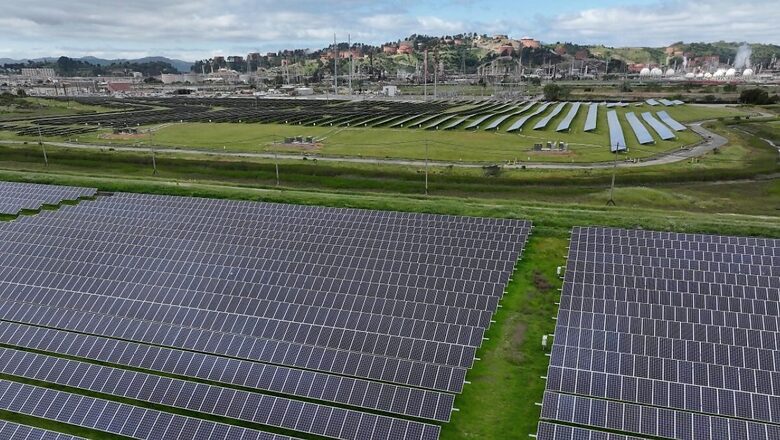
views
India’s path to the Net Zero goal of 2070 is fraught with challenges in land and water access, a key requirement for scaling up renewable energy across the country, according to a new study led by the New Delhi-based Council on Energy, Environment and Water (CEEW).
As of August 2024, India’s current installed capacity of renewable power has surged to nearly 194 GW – with an additional 5 GW of small hydro. As part of its 2030 Nationally Determined Contributions (NDCs), the country has committed to taking it to 500 GW of installed non-fossil fuel capacity largely driven by solar and wind energy.
But to achieve its long-term goal of Net Zero emissions by 2070, the CEEW estimate reveals that it will need to install over 7,000 GW of RE (5,600 GW solar wind capacity and 1,800 GW wind capacity). While the constraints are relatively manageable up to 1,500 GW, deployment beyond that is fraught with challenges in securing land and water resources and addressing population density.
RE CHALLENGE: IT’S ALL ABOUT THE LAND
The largest RE potential is from solar power and it requires extensive land resources. According to the study, the current distribution of land use will determine whether sufficient land is available for widespread RE deployment. Additionally, the location is crucial, as transmitting power over long distances is not very feasible, as well as the cost of land which will further determine the levelised cost of power.
The study found land conflicts to be a significant impediment. Only about 41 per cent of solar potential and 35 per cent of onshore wind potential are located in areas that have historically not experienced any land conflicts.
In the case of on-shore wind, only 66 per cent of the potential is concentrated in croplands, 27 per cent in rangelands, and only 7 per cent on bare ground – indicating serious challenges in accessing land for large-scale wind generation. Different state-level RE policies are another factor, as there is no standard format for reporting land-related provisions.
“India stands at a pivotal juncture in its energy transition. From land conflicts and population density to the unpredictable but undeniable impact of climate change, every step forward will demand resilience and innovation. The scale of the task ahead is monumental, yet it is precisely this challenge that will define India’s legacy as a country that charts a low-carbon pathway to prosperity against all odds,” said Dr Arunabha Ghosh, CEO of CEEW.
Population density is another factor. Only 29 per cent of onshore wind potential and 27 per cent of solar potential are located in areas with a population density lower than 250 people per square kilometre. However, social conflicts could arise even in areas with low population densities. Other factors like seismic activity and climate risks are less of a concern, as 83 per cent of onshore wind and 77 per cent of solar potential are located in low to moderate-seismic zones.
‘TAP INTO AGRO-VOLTAICS POTENTIAL IN CROPLANDS’
According to the team, one of the solutions lies in exploring the potential of agrivoltaics. Not all of these will be suitable for agrivoltaics. However, even utilising a fraction of the cropland, particularly horticultural areas for generating RE will substantially contribute to national targets and farmer incomes. India had over 28 million hectares of land under horticulture in 2021 with a solar potential of 13,875 GW.
Experts also recommended measures to halt the growth of desertification in states like Rajasthan, which can be detrimental to the development of RE. Over 16,980 square kilometres of land in Rajasthan, with the best RE potential of 832 GW, is desert, the study noted. “Land and water are critical resources for scaling up RE and green hydrogen in India. Prevention of desertification and innovative solutions to address land availability, such as agro-voltaic in horticulture and rooftop solar in dense Indian cities, will be essential. Moreover, as RE projects move into areas with higher climate risks, insurance companies could increasingly hesitate to provide coverage,” said Hemant Mallya, Fellow, CEEW.
ODISHA AND MADHYA PRADESH NEW ‘RE HUBS’?
According to the study, Odisha and Madhya Pradesh can emerge as new states that can bolster India’s RE ambitions with land banks, requisite infrastructure, and seasonality advantage. At present, a large solar potential exists in Rajasthan (6,464 GW), Madhya Pradesh (2,978 GW), and Maharashtra (2,409 GW) at levelised cost of electricity (LCOEs) lower than Rs 2.8 per kWh.
Karnataka (293 GW), Gujarat (212 GW), and Maharashtra (184 GW) have the largest wind potential in India at a levelised cost lower than Rs 3.25 per kWh. Tamil Nadu has a significantly lower cost of generation than other states with a potential of 50 GW at an LCOE lower than Rs 2.65 per kWh, it noted.
The researchers mapped the country’s RE and Green Hydrogen potential by analysing the entire landmass and applying real-world constraints. The study, Unlocking India’s RE and Green Hydrogen Potential, was done by using detailed 5×5 km grid cells to understand what can actually be developed and where.




















Comments
0 comment